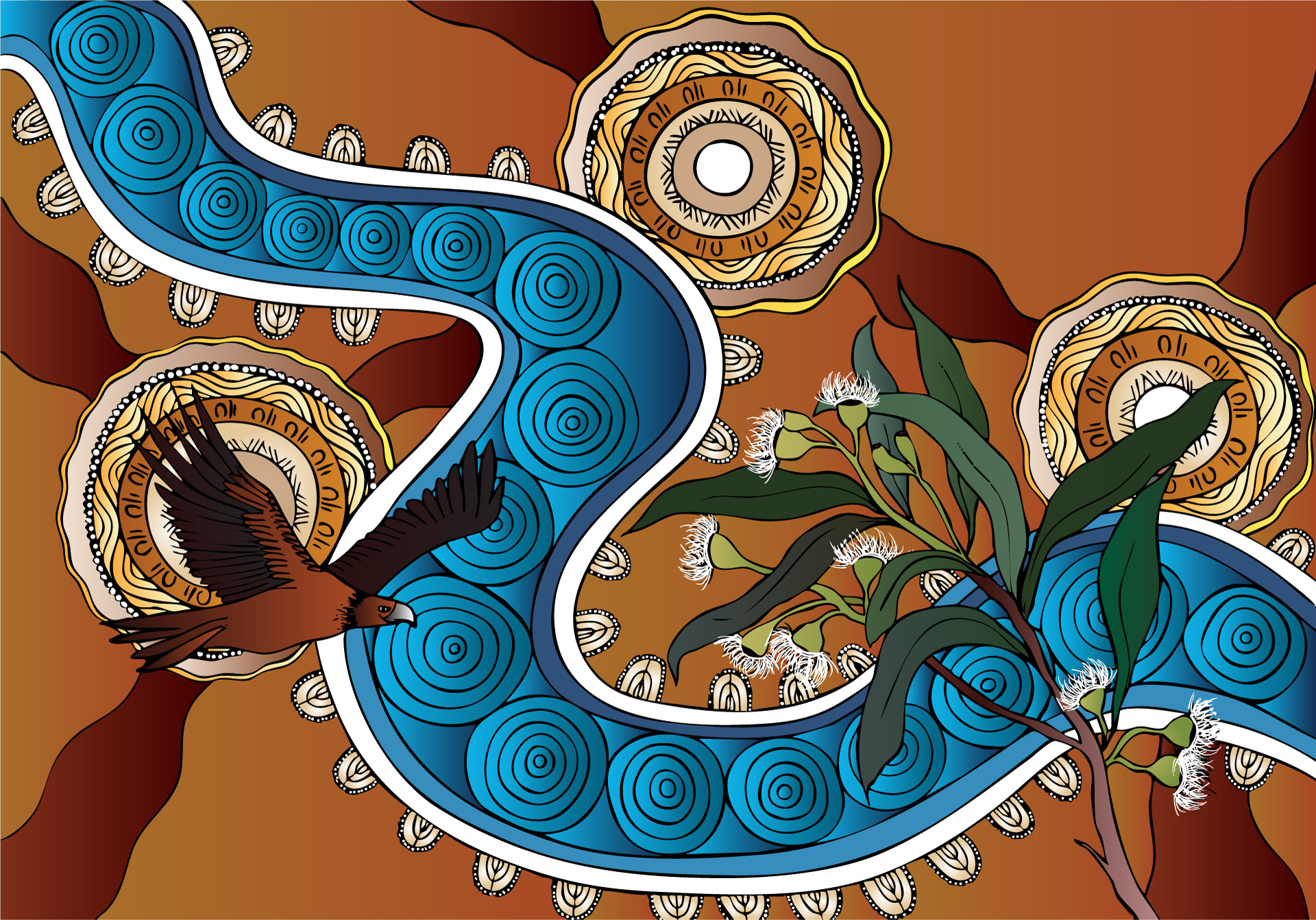Bren-nonooll Bunjil Biik - Travellers to Bunjil’s Country, by Simone Thomson
The traditional language of the Wurundjeri people is Woi-Wurrung. In the Woi-Wurrung language, the name Wurundjeri is in two parts. ‘Wurun’, meaning manna gum tree, and ‘djeri’, the white grub that lives in the bark of the tree – the witchetty grub. Flowering manna gum leaves represent the lands and waterways in which the International Geographical Congress takes place in Naarm, the place we know as Melbourne, and acknowledges its Traditional Custodians, the Wurundjeri People who have walked this land from the beginning of time, and the Boonwurung/Bunurong People who they share parts of Naarm with.
Aboriginal People have the oldest continuous living culture on Earth. Our knowledge and ceremonies have been passed down over thousands of years and conducted in the modern world. Before settlement, it is estimated there were nearly 500 countries within the land we know as Australia. Each country had its own borders and customs, languages and art styles. When travelling to another Clan territory, permission was sought to enter that country by the Elders and Senior Lore men and women. Part of this process involved cleansing the visitor of negative and bad energy before they entered to ensure they did not bring this onto their land to spoil the precious water source and taint the food, or to make people sick.
This process involved a cleansing smoke of special medicine plants and native leaves specific to that area, in which the visitor would pass through the smoke to rid themselves of negative energy. The ancestor spirits would then know that the visitor had been welcomed, and they would leave them alone to enjoy the fruits of the land. Once welcomed, the visitor would be expected to abide by that Clan’s lore and to be respectful of the land’s resources. The flowering manna gum leaves are a symbol of welcome and ceremony to the visiting nations of the International Geographical Congress.
Birrarung, the majestic river of mist and shadows known as the Yarra, weaves gently across country from its birthplace at the foothills of the southern slopes of the Great Dividing Range, to the saltwater Bay in Naarm. This significant and sacred waterway was a vital food source and means of travel for thousands of years to Wurundjeri People, and an important meeting place for inter-clan trade, ceremonies and cultural business. Birrarung is depicted from the aerial view and represents geographical land and water mapping, and is a symbol of past, present and future knowledge.
Campsites and homes are symbolised by the arced shaped mounds along the riverbank. They are the clans and tribes of the traditional custodians who have cared for and nurtured these sacred lands and waterways since time immemorial and represent the multi-cultural society that is known as Melbourne today.
The Creator Spirit for the Wurundjeri and Eastern Kulin Tribes is Bunjil who comes in the form of the wedgetail eagle. After Bunjil created the land and the mountains, the trees and flowers, he took the soft clay from the riverbank and created the form of his people. He took the string from the stringybark tree and used it for their hair, then he blew into their mouths so they could breathe. After creation, Bunjil flew into the heavens where he became the stars. That is where he remains today staring down to his people ensuring they continue to care for the land and waterways, and in return – the land and waterways will continue to provide and share its bountiful gifts.
Bunjil soars in the winds of Sky Country staring down to the waterways and ancient trade and travel routes used for millennia by visiting Clans. The trade and travel routes are symbolised by the red pathways to each gathering circle and symbolise the visiting nations of the International Geographical Congress coming from the north, east, west and southern skies in their journey tracks to Naarm. It is the connecting of cultures and the sharing of knowledge.
From the bird’s eye view, a person is represented by the ‘U’ or ‘n’ symbol. This shape symbolises a person in the sitting position on the ground with their knees crossed accompanied by their shield and spear, the two strokes – representing land knowledge and protection. People gather around each meeting place from visiting nations representing the International Geographical Congress and their collaboration of ideas, research and cultural exchange. They are visitors to Bunjil’s Country. They are Bren-nonooll Bunjil Biik.

